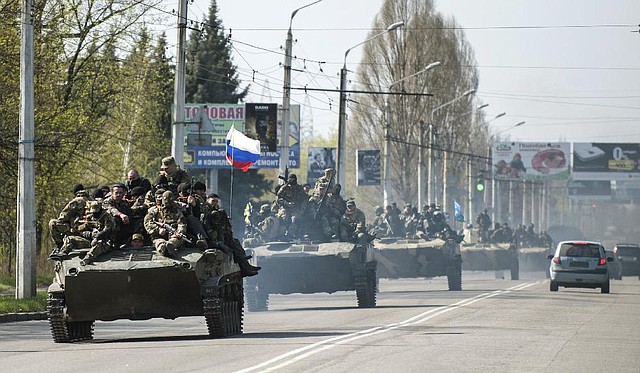Ukraine separatists seize troop vehicles
Pro-Russian insurgents drive Ukrainian armored vehicles through the eastern Ukrainian town of Kramatorsk on Wednesday after commandeering them from troops who had entered the town earlier. As Ukraine’s hopes of re-establishing control of the area dampened, NATO announced a strengthening of its military presence along some members’ borders with Russia.
Thursday, April 17, 2014
SLOVYANSK, Ukraine - Pro-Russian insurgents commandeered six Ukrainian armored vehicles along with their crews and hoisted Russian flags over them Wednesday, dampening the central government’s hopes of re-establishing control over eastern Ukraine.
The Ukrainian soldiers manning the vehicles offered no armed resistance, and masked pro-Russian militants in combat fatigues sat on top as they drove into the eastern city of Slovyansk.
In Brussels, NATO announced it was immediately strengthening its military footprint along some member nations’ eastern borders - which lie next to Russia - in response to Russia’s moves in Ukraine. U.S. President Barack Obama’s administration, meanwhile, moved to ratchet up its response, preparing new sanctions on Russia and more assistance for the struggling Ukrainian military.
Insurgents in Slovyansk have seized the police headquarters and the administration building, demanding broader autonomy for eastern Ukraine and closer ties with Russia. Their actions have been repeated in at least eight other cities in eastern Ukraine - and the central government in Kiev says Moscow is fomenting the unrest.
One of the Ukrainian soldiers from the armored vehicles said they had all defected to the pro-Russian side. But an Associated Press journalist overheard another soldier suggesting they were forced at gunpoint to handover the vehicles.
“How was I supposed to behave if I had guns pointed at me?” the soldier, who did not identify himself, asked a resident.
Breaking hours of silence, the Ukrainian Defense Ministry issued a statement saying Ukrainian troops had entered Kramatorsk, south of Slovyansk, on Wednesday morning, where locals and “members of Russian sabotage groups” seized six armored personnel vehicles and drove them to Slovyansk, where they were greeted by a cheering crowd of 1,000 people.
The military said “the whereabouts of the Ukrainian servicemen” were not yet known. The Interfax news agency quoted Miroslav Rudenko, one of the insurgent leaders in Slovyansk, as saying the soldiers will be offered the chance to join a local militia or leave the region.
Later Wednesday, in Pchyolkino, a town south of Slovyansk, tensions boiled over as several hundred residents surrounded 14 Ukrainian armored vehicles. Fearing the troops were sent to quell them, the crowd refused to let the vehicles leave despite the pleas of a Ukrainian officer. The crowd was later reinforced by pro-Russian gunmen.
To end the standoff, leaders in the crowd told Lt. Colonel Oleksandr Shvets they would let his 100 troops go if they handed over the magazines from their assault rifles. The soldiers took the magazines off, put them in plastic bags and gave them to the pro-Russian insurgents.
NATO Secretary-General Anders Fogh Rasmussen, meanwhile, said NATO will respond to what he called Russian aggression in Ukraine. NATO aircraft will fly more sorties over the Baltic region, and allied ships will deploy to the Baltic Sea, the eastern Mediterranean Sea and elsewhere if needed.
NATO says Russia has up to 40,000 troops stationed near its border with Ukraine. Western nations and the new government in Kiev fear that Moscow will use unrest in eastern Ukraine as a pretext for a military invasion.
Ukraine is not a NATO member, but several NATO members - Lithuania, Latvia, Estonia and Poland - border Russia. NATO members Bulgaria, Romania and Turkey also border the Black Sea, along with Russia and Ukraine.
In Washington, D.C., officials said Wednesday that the United States is working on a package of nonlethal aid for Ukraine that could include medical supplies and clothing, but would stop short of providing body armor and other military-style equipment.
Obama’s administration has said it is considering aid requests from Ukraine but is not actively considering sending weapons, ammunition or other lethal assistance.
U.S. officials also said they had no plans to levy new sanctions ahead of today’s talks in Geneva between the U.S., Russia, Ukraine and the European Union. But with low expectations for a breakthrough in those meetings, officials already have prepared targets for sanctions that include wealthy individuals close to Russian President Vladimir Putin and the entities they run.
“Each time Russia takes these kinds of steps that are designed to destabilize Ukraine and violate their sovereignty, there are going to be consequences,” Obama said in an interview with CBS News. “Mr. Putin’s decisions aren’t just bad for Ukraine. Over the long-term, they’re going to be bad for Russia.”
A senior State Department official suggested Kiev was preparing to take a more appeasing approach with Moscow during the talks, with Ukrainian diplomats preparing to brief Russia on efforts to give more autonomy to regions, protect Russian-speaking minorities and allow widespread inclusion of candidates in upcoming presidential elections.
Kremlin officials acknowledged Wednesday that Russia’s annexation of Ukraine’s Crimea region last month and the instability it created in Russian financial markets prompted record capital flight of $63 billion in the first quarter and sharply downgraded growth forecasts for the country. Finance Minister Anton Siluanov said that instead of projected 2.5 percent growth this year, Russia’s economy might show no growth at all.
Information for this article was contributed by Peter Leonard, Maria Danilova, Nataliya Vasilyeva, Laura Mills, Juergen Baetz, Julie Pace, Robert Burns and John-Thor Dahlburg of The Associated Press; and by Sergei L. Loiko, Carol J. Williams, David S. Cloud and Victoria Butenko of the Los Angeles Times.
Front Section, Pages 5 on 04/17/2014

